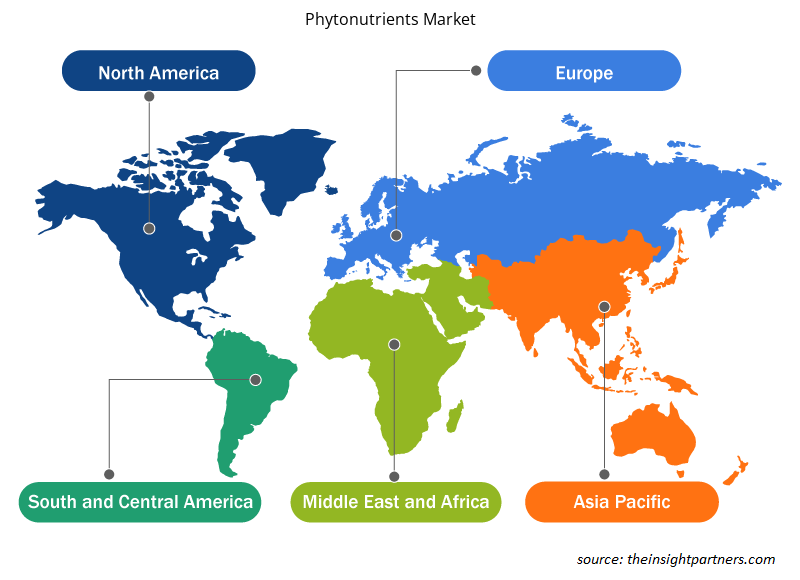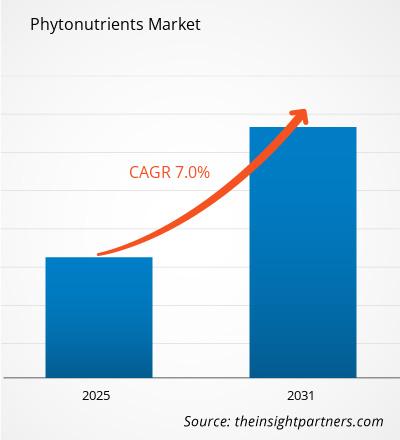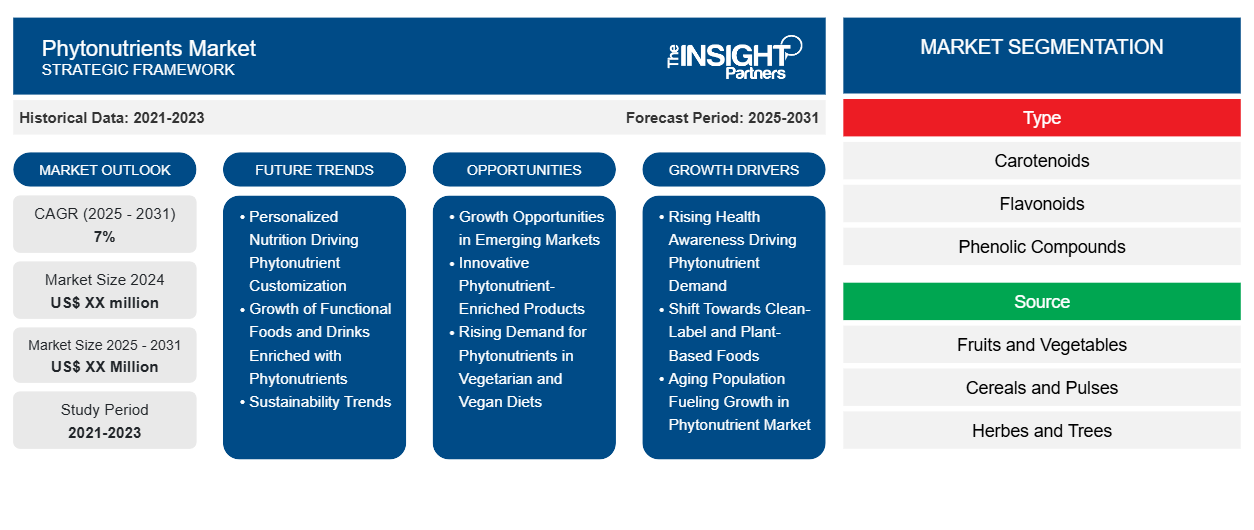植物营养素市场预计在 2023 年至 2031 年期间的复合年增长率为 7%,市场规模将从 2023 年的 XX 百万美元扩大到 2031 年的 XX 百万美元。
植物营养素市场报告按类型(类胡萝卜素、黄酮类化合物、酚类化合物、植物固醇等)进行细分。市场根据来源(水果和蔬菜、谷物和豆类、草本植物和树木等)进行细分。市场根据应用(医药、食品和饮料、化妆品、动物营养等)进行细分。全球分析进一步细分为区域和主要国家。范围涵盖所有关键细分市场的全球、区域和国家层面的市场规模和预测。该报告以美元为单位提供了上述分析、细分市场、地区和国家的价值。报告涵盖市场趋势以及市场动态,如驱动因素、限制因素和关键机会。报告还涵盖行业格局和竞争分析,包括市场集中度、热图分析、知名参与者和市场最新发展。
报告目的
Insight Partners 的《植物营养素市场》报告旨在描述当前形势和未来增长、主要驱动因素、挑战和机遇。这将为各种业务利益相关者提供见解,例如:
- 技术提供商/制造商:了解不断变化的市场动态并了解潜在的增长机会,从而能够做出明智的战略决策。
- 投资者:对市场增长率、市场财务预测以及整个价值链中存在的机会进行全面的趋势分析。
- 监管机构:监管市场政策和警察活动,旨在最大限度地减少滥用行为,维护投资者的信任和信心,维护市场的完整性和稳定性。
植物营养素市场细分
类型
- 类胡萝卜素
- 黄酮类化合物
- 酚类化合物
- 植物固醇
来源
- 水果和蔬菜
- 谷物和豆类
- 草本植物和树木
应用
- 制药
- 食品和饮料
- 化妆品
- 动物营养
地理
- 北美
- 欧洲
- 亚太
- 南美洲和中美洲
- 中东和非洲
地理
- 北美
- 欧洲
- 亚太
- 南美洲和中美洲
- 中东和非洲
定制此报告以满足您的需求
您可以免费定制任何报告,包括本报告的部分内容、国家级分析、Excel 数据包,以及为初创企业和大学提供优惠和折扣
-
获取此报告的关键市场趋势。这个免费样品将包括数据分析,从市场趋势到估计和预测。
植物营养素市场增长动力
- 不断增强的健康意识推动植物营养素需求:消费者不断增强的健康意识和保健关注是植物营养素市场增长的主要因素之一。随着人们对健康与饮食之间因果关系的认识不断提高,许多人现在都在寻找有助于改善健康的产品,尤其是天然和植物性产品。植物营养素是一类化合物,包括但不限于黄酮类化合物、胡萝卜素类化合物和多酚类化合物,具有帮助预防、对抗和治愈疾病的特性。这反过来又导致植物营养素补充剂和功能性食品的供应和消费增加,这些食品旨在帮助增强免疫力和疾病管理和歧视健康问题。
- 转向清洁标签和植物性食品:近年来,向清洁标签、有机和全天然食品的转变一直在稳步上升。人们已经转向寻求不含人工添加剂和化学物质的食品,其中大多数人更喜欢在饮食中添加有机和植物性食品添加剂。植物营养素是吸引这一领域的一种营养素,因为它们来自水果、蔬菜、草药和香料,因此可以轻松添加到食物和饮料中。随着越来越多的人避免食用肉类和其他动物产品以及有机产品,富含植物营养素的替代品的供应可能会扩大。
- 人口老龄化推动植物营养素市场增长:全球老年人口的增加是推动植物营养素市场增长的另一个潜在因素。随着年龄的增长,许多人可能会出现健康并发症,包括但不限于心脏并发症、糖尿病、精神疾病和身体防御机制减弱。在这种情况下,与年龄有关的疾病已经证明,植物中存在的营养素可以成功治疗此类疾病。例如,氧化应激可以通过多酚和类胡萝卜素等抗氧化剂缓解。
植物营养素市场未来趋势
- 个性化营养推动植物营养素定制:个性化营养率的上升意味着植物营养素将更多地用于定制健康解决方案。基因组学和营养科学的先进进步使得根据每个用户的需求、健康、基因特征和生活方式提供个性化建议成为可能。出于对心脏健康、大脑健康甚至抗衰老等因素的担忧,公司预计将开始生产先进的定制植物营养素食品补充剂。这是因为很多人开始注重健康,因此他们会寻求解决方案而不是治疗。
- 富含植物营养素的功能性食品和饮料的增长:另一个新兴趋势是将植物营养素加入功能性食品和饮料中。健康功能性食品(即在普通食品的基础上提供额外健康益处的食品)将获得市场认可,因为人们希望过上更健康但更忙碌的生活。这些食品可能包括软饮料和太妃糖,除了食品外还含有有益健康的成分,例如音乐增强剂,包括抗氧化剂、维生素和矿物质。例如,在能量饮料、植物蛋白棒,甚至益生菌乳制品等增值产品中,食品制造商将寻求加入植物成分,因为消费者想要更健康、功能更强大的食品。
- 可持续性趋势:影响食品和饮料行业所有领域(包括植物营养素市场)的趋势之一是可持续性。当今的消费者和公司对其产品中使用的成分对环境的影响更加谨慎。随着年轻人更加关注无肉选择,公司将更加热衷于绿色采购和农业实践,并在其产品中使用更多植物营养素成分。
植物营养素市场机会
- 新兴市场的增长机会:植物营养素市场是高增长的新兴市场,因此为亚太、拉丁美洲和非洲等地区的植物营养素市场提供了巨大的增长机会。可支配收入不断增加、信息获取渠道不断增加、健康意识不断提高,这些地区的消费者开始寻求天然、有益健康的产品。功能性食品、膳食补充剂和有机产品的日益普及将使这些地区蓬勃发展,为制造商提供了在这些高增长地区快速扩张的机会。此外,这些地区的人们在传统美食中会烹制富含植物营养素的食物,因此市场增长前景广阔。
- 创新的富含植物营养素的产品:随着越来越多的人愿意为突破性的健康服务和产品支付更多的钱,人们开始将原始的想法转化为富含植物营养素的产品。新产品可以是富含植物营养素的饮料,甚至是功能性食品,这些食品与其他治疗剂结合在一个包装中,为消费者带来更多的治疗效果。例如,浆果、姜黄和其他富含抗氧化剂的超级食品可以与益生元和益生菌或蛋白质一起使用,以针对追求健康的消费者,提供一种包含多种添加剂的产品,这些添加剂可以很好地协同作用。开发此类创新产品将有助于公司在已经饱和的市场中竞争。
- 素食和纯素食饮食对植物营养素的需求不断增长:随着越来越多的人采用素食和纯素食生活,植物营养素市场有机会通过比以往更好地获取植物源营养素而实现增长。纯素食和素食消费者比健康饮食者更倾向于不含动物产品的富含植物营养素的食物。
植物营养素市场区域洞察
Insight Partners 的分析师已详细解释了预测期内影响植物营养素市场的区域趋势和因素。本节还讨论了北美、欧洲、亚太地区、中东和非洲以及南美和中美洲的植物营养素市场细分和地理分布。

- 获取植物营养素市场的区域特定数据
植物营养素市场报告范围
| 报告属性 | 细节 |
|---|---|
| 2023 年的市场规模 | XX 百万美元 |
| 2031 年市场规模 | XX 百万美元 |
| 全球复合年增长率(2023 - 2031) | 7% |
| 史料 | 2021-2022 |
| 预测期 | 2024-2031 |
| 涵盖的领域 |
按类型
|
| 覆盖地区和国家 |
北美
|
| 市场领导者和主要公司简介 |
|
植物营养素市场参与者密度:了解其对业务动态的影响
植物营养素市场正在快速增长,这得益于终端用户需求的不断增长,而这些需求又源于消费者偏好的不断变化、技术进步以及对产品益处的认识不断提高等因素。随着需求的增加,企业正在扩大其产品范围,进行创新以满足消费者的需求,并利用新兴趋势,从而进一步推动市场增长。
市场参与者密度是指在特定市场或行业内运营的企业或公司的分布情况。它表明在给定市场空间中,相对于其规模或总市场价值,有多少竞争对手(市场参与者)存在。
在植物营养素市场运营的主要公司有:
- 阿彻丹尼尔斯米德兰公司
- 巴斯夫
- 嘉吉公司
- 科汉森公司
- 氰特科技股份有限公司
免责声明:上面列出的公司没有按照任何特定顺序排列。

- 了解植物营养素市场主要参与者概况
主要卖点
- 全面覆盖:报告全面涵盖了植物营养素市场的产品、服务、类型和最终用户的分析,提供了整体概况。
- 专家分析:报告基于对行业专家和分析师的深入了解而编写。
- 最新信息:该报告涵盖了最新信息和数据趋势,确保了其与业务的相关性。
- 定制选项:此报告可以定制以满足特定客户要求并恰当地适应业务策略。
因此,植物营养素市场研究报告有助于引领解读和了解行业情景和增长前景。尽管可能存在一些合理的担忧,但本报告的总体优势往往大于劣势。
- 历史分析(2 年)、基准年、预测(7 年)及复合年增长率
- PEST和SWOT分析
- 市场规模、价值/数量 - 全球、区域、国家
- 行业和竞争格局
- Excel 数据集
近期报告
客户评价
购买理由
- 明智的决策
- 了解市场动态
- 竞争分析
- 客户洞察
- 市场预测
- 风险规避
- 战略规划
- 投资论证
- 识别新兴市场
- 优化营销策略
- 提升运营效率
- 顺应监管趋势























 获取免费样品 - 植物营养素市场
获取免费样品 - 植物营养素市场